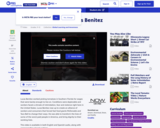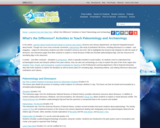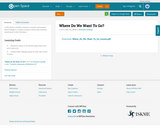
In this media gallery, follow Neeraj, from Rajasthan, India over the course of 12 years as she struggles to gain an education. [3:44]
- Subject:
- Social Studies
- Material Type:
- Lesson
- Provider:
- PBS LearningMedia
- Date Added:
- 12/01/2022

In this media gallery, follow Neeraj, from Rajasthan, India over the course of 12 years as she struggles to gain an education. [3:44]

Lucas Benitez worked picking tomatoes in Southern Florida for wages that were barely enough to live on. Conditions were deplorable and workers faced a climate of intimidation, fear and violence right here in the United States. Lucas Benitez rose up to create an alliance of workers and consumers that forced fast food giants McDonalds and Taco Bell to change their ways. He was able to transform the lives of some of the worst paid people in America, and bring dignity to their working lives. [11:04]

A large collection of historical photos showing the traditional lifestyles of the Metis. The photos are sorted into categories, e.g., food preparation, hunting, trapping, etc.

The many forms of housing and shelter that the Metis used are presented. Discussion questions and a bibliography can be found at the end of the article.

The Metis travelled by Red River cart, canoe, horse, snowshoe, sled dogs and in other ways, all of which are described in this paper. Discussion questions and a bibliography are included.

Discover this global career path that requires two or more languages - and see if it speaks YOUR language.
See the Lab Squad kids’ report for this career in Support Materials +

In this video from Wide Angle, visit a makeshift night school in rural India designed to allow child laborers who work during the day to obtain an education.

Art and music were not exempt from receiving Hitler's influence during the holocaust. Here you can view Nazi approved art, art considered "degenerate," art from inside the camps and ghettos, and art inspired by the holocaust. This is a comprehensive site that has many resources including lesson plans.

A broad overview of the history, structure, and accomplishments of the United Nations. Students review an overview of the institution and develop brief presentations in a group activity following a set of discussion questions.

Learn about Santosh Kohli, a young woman from a traditional Indian family of modest means, as she gains self sufficiency and determination. [2:53]

Museum exhibition canvasses the design of the cold war period. The focus of the exhibition is on making the connections between artistic production of the time and the era's prevailing political and social ideas.

In this ZOOM video segment, cast member Francesco follows the paper trail to find out what happens to his recyclables. He visits a material recovery center and learns how paper is recycled and the number of trees that are saved as a result.
![Vocabulary [Lesson 1 of 20]](https://openspace.infohio.org/static/newdesign/images/materials/default-thumbnail-index.png)
Students learn about the concept of Afrofuturism, Black Speculative Fiction, and the term "Sower". The main focus of the lesson will be a design challenge where students are tasked with creating a drawing in an Afrofuturism theme with the guidance of an award-winning illustrator. The class has the opportunity to share their work for potential inclusion in an educational archive. This lesson helps students deepen their understanding of Afrofuturism and express their creativity.
Estimated time required: 1-2 class periods.
Technology required for this lesson: Augmented Reality, Internet Connectivity, Laptop/Desktop, Smartphone, Tablet, Tablet or Smartphone.

Students explore a variety of sources for information about voting. They evaluate the information to determine if it is fact or opinion, and then create a graffiti wall about voting.

World War I Teaching Resources. Lesson II: Exploring the essentials. This adaptable WWI Curriculum builder teaches the context of WWI as a global event, America's neutrality and its cathartic entry into this unprecedented, cataclysmic global conflict. Beyond those fundamentals, additional resources can scaffold into curricula as short as 1 day or as extensive as 5+ days by looking at the dramatic social effect of WWI in America through the lens of: Women; African Americans; Native Americans; American Immigrants; Citizenship; The Bill of Rights; Propaganda; more.. "Interactive" and "Streaming" tracks support school environments with differing technical resources. A 20-page WWI history eBooklet called "The United States in WWI" supplements your existing history textbooks.
Estimated time required: 1-6 class periods.
Technology required for this lesson: Augmented Reality, Internet Connectivity, Tablet or Smartphone.

World War I Teaching and Learning Resources - Lesson I: Preparation and Overview. Lesson I is not necessarily intended to be part of a WWI Syllabus - though it can be. It's intention is to create familiarity with the installation, technical compatibility, and tools available in the WWI Memorial "Virtual Explorer" App. It's for teacher's preparing to use the "WWI Memorial Virtual Explorer" A/R app tools, and tech-support persons installing the Apps. Lesson I can also be used for a class activity with an overview lesson in Augmented Reality... It includes a student worksheet exploring timeline-based ideas using the "WWI timeline-tower" A/R feature. Tools allow teachers to invent their own timeline based exercises that may be useful for "common standard" skills unrelated to WWI, but teach event relationships.
Estimated time required: 1 class period.
Technology required for this lesson: Augmented Reality, Tablet or Smartphone.

Learners start by using the Arcadia Earth app’s Keep the Great Lakes GREAT section to glean base knowledge of freshwater’s importance, processes, impacts, and conservation needs. Students will then extend their knowledge to discover water-land and water-human interactions. This lesson incorporates two activities. The first, Water Slope, helps students understand how water interacts with land as it moves through the soil. The second activity, Drip Drop, demonstrates water waste they may encounter in
their everyday lives. Students conclude by discussing possible solutions for water conservation in their communities.
Estimated time required: 1 class period.
Technology required for this lesson: Tablet or Smartphone.

Animal shelters euthanize animals when no one adopts them. According to Joyce, the narrator of this segment, 26,000 dogs a year are picked up by Albuquerque Animal Services. To help find homes for the unwanted pets, Joyce, who is also a photographer, takes pictures of the dogs and posts the pictures on the Internet. She hopes when people see the dogs on the Internet they have an added incentive to come to the shelter to take them home. In this video segment from WILD TV, learn more about Joyce and her efforts to find homes for unwanted pets in Albuquerque. For more about animal shelters, see video segment "Animal Shelter".

This article provides links to interactive web sites and lesson plans for teaching about paleontology, dinosaurs, and archaeology in the elementary classroom.

In this lesson, students research a location and present their findings in a variety of ways to share why someone would want to visit this place.